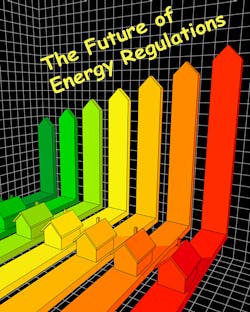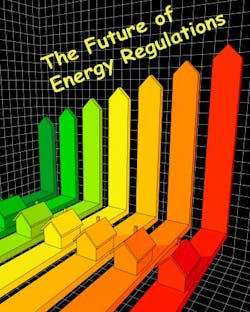I have a meeting with a group of energy regulators from Washington, DC tomorrow. My role in this meeting is to represent HVAC contractors who actually work in the field. My presentation at this meeting will describe elements of what HVAC energy efficiency may become in the future.
Over the past month, in preparation for this meeting, I reached out to a number of the heavy-hitters in the NCI Performance-Based contracting world for their opinions on this. For the purposes of this article, I combined their comments into synopsis statements. Let’s take a look at what they said.
High Efficiency Equipment Isn’t “Rob, please help these regulators see that equipment rated in the lab, doesn’t automatically deliver that efficiencyThese contractors know from hands-on experience that the marketing hype singing the virtues of high efficiency equipment has led the public astray. It has gone on so long, it borders on becoming a liability because it’s misleading to consumers.
The average commercial or residential HVAC system delivers well below 60% of equipment rated capacity in real field conditions. In other words, 18-SEER equipment characteristically produces less efficiency than a 10 SEER system on the typical duct system.
These contractors know there is more to system efficiency than just high efficiency equipment. They are sure regulators haven’t measured and scored HVAC system efficiency in the field because they don’t speak in terms of field data they have collected.
The average commercial or residential HVAC system delivers well below 60% of equipment rated capacity in real field conditions. In other words, 18-SEER equipment characteristically produces less efficiency than a 10 SEER system on the typical duct system.
Move Beyond Equipment Efficiency Ratings
“Rebates based on equipment efficiency ratings are a waste of money.”
The recommendation is to pay for measured and verified performance. In other words, prove the work truly perform as it was intended. This way the riff-raff will get out of utility programs and only top quality companies that actually make efficiency happen will be able to participate. “The others are welcome to learn how and join us at any time they can prove they can deliver the goods through measurement.”
Dump the Building Science Testing
“Current building science HVAC testing attempts to give the illusion of performance and efficiency, but fails to deliver it.”
The HVAC professionals I spoke with have developed the skills to test and diagnose systems. Through testing and diagnosis, they have the ability to identify and deliver custom HVAC system repairs to increase system efficiency. These are HVAC solutions, not science experiments modeled to save energy.
The HVAC professionals I spoke with have developed the skills to test and diagnose systems. Through testing and diagnosis, they have the ability to identify and deliver custom HVAC system repairs to increase system efficiency. These are HVAC solutions, not science experiments modeled to save energy.
Energy Efficiency Measures Don’t Work
“Efficiency has no gimmicks, just sound principles of physics”
HVAC professionals are in the business of measuring, diagnosing, and fixing HVAC systems. Most people in the industry understand that for decades, the long list of disconnected energy efficiency measures have failed to deliver promised savings.
Remove incentives and the measures go away. The market never has been or will be transformed by widgets.
Checklists Don’t Work
“Efficiency is holistic. Checklists are unable to find and solve the causes of poor energy efficiency.”
HVAC professionals who measure and verify actual HVAC system performance understand the checklist approach to installing equipment to achieve efficiency lacks the substance to deliver it in the field.
Efficiency is a holistic assessment of a system’s performance. “The attempt to hide behind a list and insinuate performance earned without measuring has already met its fate in the field. Energy efficiency programs are trying to keep it on life support with ratepayer dollars.”
Each System is Unique
“Improvements needed to optimize HVAC system efficiency are unique. Systems need targeted surgical procedures, not x-rays.”
No two systems are installed exactly the same. For this reason, the cause of poor performance is peculiar to each system. Furthermore a combination of surgical repairs is usually needed to earn increased efficiency.
In other words, specific customized repairs discovered through advanced diagnostics create improved efficiency, not a list of energy efficiency measures or gimmicks.
No two systems are installed exactly the same. For this reason, the cause of poor performance is peculiar to each system. Furthermore a combination of surgical repairs is usually needed to earn increased efficiency.
It’s Hard to Make Real Efficiency
“We hear regulators talk about leveling the playing field: why not bring the level of the field up to where we play? We welcome qualified competition.”
Contractors who actually deliver efficiency are well aware of how difficult it can be to test and diagnose each individual HVAC system. Effective technical training, proper test instruments, certification, and coaching are necessary to boost energy efficiency in a new or existing system.
Who Asked for Energy Raters?
“I know several fantastic energy raters; they all work for me now.”
The debacle of creating an entire industry to verify the actions of the HVAC industry is still a mystery to these HVAC experts. Although the effort had little effect on efficiency, it has enlisted many eager and talented professionals into the HVAC industry. When real efficiency is measured, the need for industries outside of ours to police our work disappears.
Effective HVAC Technical Training
“Programs that require training and certification are needed, not training to fill out rebate forms.”
It’s astounding to find utility programs that only offer training to fill out rebate forms. How can an expectation to transform the market be expected without effective technical training and coaching in the field? Training must be solutions-based instead of matching the numbers to truly transform the market.
Do It Our Way
“Contractors have the highest ability to deliver energy efficiency. We are anxious for regulators to step up to the way the HVAC industry has been doing it for decades – right under their noses, with zero acknowledgement of our achievements.”
I was stunned by this statement. It was spoken with confidence, and with calm respect for the evolution of the energy efficiency industry.
There has been an evolution, but the pace of this evolution is approaching shameful. Many of those I spoke with have genuine concerns about the size of the public relations nightmare regulators have created. By failing to respond to better efficiency opportunities, these relationships may not be repairable.
The Energy Efficiency Programs of the Future
So, there you have it. These statements and descriptions are straight from qualified HVAC professionals who can and do regularly deliver the highest available measured HVAC system efficiency in the field.
Can you see a description forming of what these folks envision future HVAC energy efficiency programs should look like?
Interestingly, most of the people I interviewed don’t actually participate in current utility programs. Each has implemented technical and business practices that enable them to build strong testing and teaching protocols. Their business models don’t require incentives to encourage customers to purchase energy efficiency.
They are each energy hero in their own right, waiting for energy efficiency programs to catch up with them. “Is there a concern if programs come into your market,” I asked. The typical response was “Heck no, that will just push us farther ahead of the market.”
Rob “Doc” Falke serves the industry as president of National Comfort Institute -- an HVAC-based training company and membership organization. If you're an HVAC contractor or technician interested in a free procedure on how to use an air balancing hood, contact Doc at [email protected] or call him at 800-633-7058. Go to NCI’s website at nationalcomfortinstitute.com for free information, articles, and downloads.
About the Author
Rob 'Doc' Falke
President
Rob “Doc” Falke serves the industry as president of National Comfort Institute an HVAC-based training company and membership organization. If you're an HVAC contractor or technician interested in a building pressure measurement procedure, contact Doc at [email protected] or call him at 800-633-7058. Go to NCI’s website at NationalComfortInstitute.com for free information, articles and downloads.

